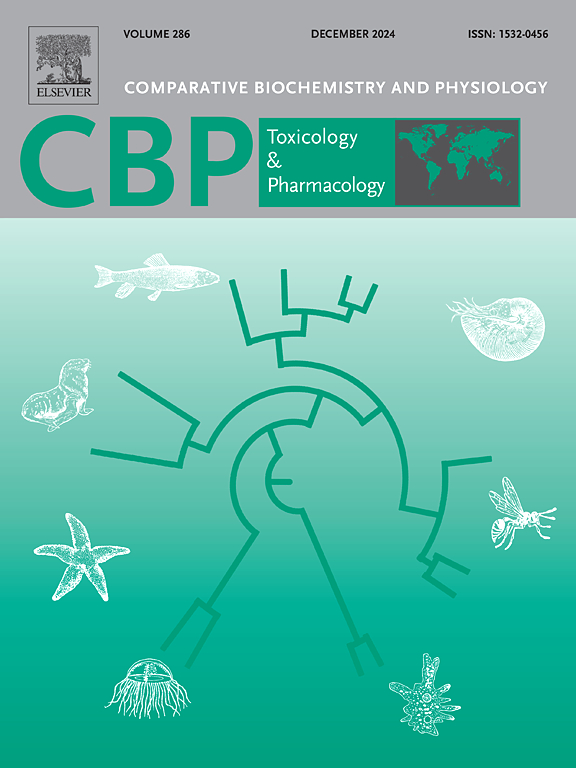环境盐度对线虫MAPK-NFAT5通路的影响及其在渗透调节中的作用
IF 4.3
3区 环境科学与生态学
Q2 BIOCHEMISTRY & MOLECULAR BIOLOGY
Comparative Biochemistry and Physiology C-toxicology & Pharmacology
Pub Date : 2025-03-31
DOI:10.1016/j.cbpc.2025.110201
引用次数: 0
摘要
在全球范围内,海平面上升导致沿海淡水盐碱化,生物可能受到影响,进而促进渗透调节和适应淡水盐碱化。作为淡水龟的一种,elegans对不同盐度环境表现出显著的耐受性,但其潜在的调节机制尚不清楚。本研究旨在基于以往的RNA-seq数据阐明该物种渗透调节的分子机制。我们的研究结果表明,当暴露于5 PSU(5 ‰)和15 PSU(15 ‰)的盐度时,海龟表现出尿液中离子(Na+, K+)和尿素浓度的增加,同时血浆和尿液中的渗透压升高。此外,盐水中肾水通道蛋白(AQPs)、离子转运体和有机渗透物的蛋白水平上调。值得注意的是,高渗调节因子NFAT5的转录水平显著升高,并伴随着肾小管上皮细胞细胞核磷酸化NFAT5水平的增加。此外,我们观察到盐水中MAPKs的磷酸化水平上调。使用MAPK抑制剂可以有效阻断NFAT5和渗透调节靶基因的转录。综上所述,这些结果表明,秀丽隐杆线虫激活MAPK-NFAT5信号通路来调节渗透压,以适应咸水环境。我们的研究为水生生物对盐水环境的渗透调节反应提供了有价值的见解,并有助于理解居住在海平面上升的沿海地区的生物的适应性。本文章由计算机程序翻译,如有差异,请以英文原文为准。

Impact of environmental salinity on the MAPK-NFAT5 pathway in Trachemys scripta elegans and its role in osmoregulaton
Globally, sea level rise (SLR) leads to salinization of coastal freshwater, in where organisms might be affected and in turn promote osmoregulation and adaptation in response to freshwater salinization. Trachemys scripta elegans a freshwater turtle species, exhibits remarkable tolerance to varying salinity environments, yet the underlying regulatory mechanisms remain poorly understood. This study aimed to elucidate the molecular mechanisms of osmoregulation in this species based on previous RNA-seq data. Our findings revealed that when exposed to 5 PSU (5 ‰) and 15 PSU (15 ‰) salinities, the turtles exhibited increased concentrations of ions (Na+, K+) and urea in urine, along with elevated osmotic pressures in both plasma and urine. Additionally, the protein levels of aquaporins (AQPs) and transporters of ions and organic osmolytes in the kidney were upregulated in saline water. Notably, the transcriptional level of the hypertonic regulator NFAT5 was significantly elevated, accompanied by an increase in phosphorylated NFAT5 levels in the nucleus of renal tubular epithelial cells. Furthermore, we observed upregulated phosphorylated levels of MAPKs in saline water. The use of MAPK inhibitors effectively blocked the transcription of NFAT5 and osmoregulatory target genes. Collectively, these results suggest that T. scripta elegans activates the MAPK-NFAT5 signaling pathway to modulate osmotic pressure in adaptation to saline water environments. Our study provides valuable insights into the osmoregulatory responses of aquatic organisms to saline environments and aids in understanding the adaptability of organisms inhabiting coastal areas facing rising sea levels.
求助全文
通过发布文献求助,成功后即可免费获取论文全文。
去求助
来源期刊
CiteScore
7.50
自引率
5.10%
发文量
206
审稿时长
30 days
期刊介绍:
Part C: Toxicology and Pharmacology. This journal is concerned with chemical and drug action at different levels of organization, biotransformation of xenobiotics, mechanisms of toxicity, including reactive oxygen species and carcinogenesis, endocrine disruptors, natural products chemistry, and signal transduction with a molecular approach to these fields.

 求助内容:
求助内容: 应助结果提醒方式:
应助结果提醒方式:


